Things as they ought to be…
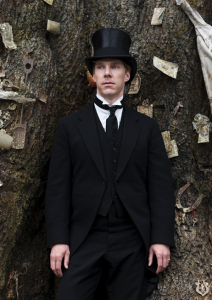
Benedict Cumberbatch as Christopher Tietjens stands before the ancient cedar, the Groby Tree.
(Parade’s End Screenshot).
Complications and Anticipations
A chance encounter with the unfamiliar…a Sheffield Billiken lends itself for today’s discussion of the film series Parade’s End. Based on four books written by Ford Madox Ford the novels are: Some Do Not (1924), No More Parades (1925), A Man Could Stand Up (1926) and Last Post (1928). The tetralogy visits the life of Christopher Tietjens, played by Benedict Cumberbatch in the film series and though Billiken does not feature, Billiken, The God of Things as They Ought to Be surely must be present…Perhaps an earlier Totoro within the Tietjens’ Groby tree?
The word Billiken first appears in an 1896 poem by Canadian poet laureate Bliss Carman entitled Mr. Moon: A Song of the Little People. Some years later an American art teacher and illustrator, Florence Pretz, may have chosen Billiken, from Carman’s poem, to name a vision she saw in a dream. Pretz turned her vision into a design, established a patent on the work and in 1908 sold the design to the Billiken Company of Chicago. Although popular in America for a few years Billiken did not fade into obscurity but became enshrined in Japan before the Second World War.
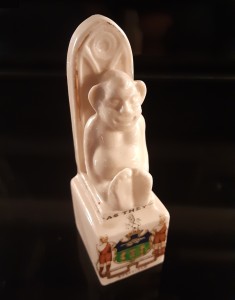
Sheffield crested china figure depicting Billiken. Similar good luck charms include Fumsup (Touch Wood) and the Lincolnshire Imp.
A Billiken is a talisman of luck…buy one and Billiken brings the purchaser good luck, gift Billiken to someone and the recipient will enjoy even greater luck. Make a wish and rub Billiken’s feet…wish upon a star…drop coins into a fountain…always put the left shoe on first….luck, superstition it does not so much follow us…rather (perhaps) we seem to choose or suggest we have found it. Charms, talisman are important to people…they can be deeply rooted or fleeting…they create belief…and hope.
The returning visual of the Tietjens family ancient and learned Groby tree…deeply rooted upon the family estate is filled with these charms. Perhaps the ancient tree’s charms…its tilting memories will reveal secrets and passions? Perhaps its charms will provide the Billiken dreams of Christopher, Sylvia, Valentine, and Mark, their friends, comrades and acquaintances as gentle winds taunt the Groby’s charms to motion…of things as they ought to be.

Medallion depicting St. Anthony, the saint of lost things.
In Parade’s End Sylvia tells Christopher,
“I still wear my St. Anthony to…look after you…see.”
(Vatican image)
Of the complications and anticipations in Christopher Tietjens’ time is the calamity of the Great War. Injured in an explosion on the Western Front Christopher, upon returning home to Sylvia, provides the descriptions of his horror of survival on the Western Front. There is no luck here…though Sylvia may clutch to her St. Anthony’s medallion…fire and demons come to mind… when she asks, “Would you mind telling me what actually happened to you?” After some disingenuous chatter between them Christopher begins as if a thousand stars away…
Christopher Tietjens (Benedict Cumberbatch) describing artillery fire.
“…you can’t possibly conceive of the quantity of explosives the armies throw at each other for each man killed…Shells make a continuous noise sometimes like…an enormous machine breaking apart…Other times…they come whistling towards you in a thoughtful sort of a way and then go crump and…the screwcap flies off hurtling through the air screaming…This one kind of shell…which comes with a crescendo like an express train only faster. Another kind which makes a noise like…tearing calico louder and louder…The largest kind are the ones which burst in the sky, make a double crack like…wet canvas being shaken out by a giant….Such immense explosions that kill such…small…weak animals.”
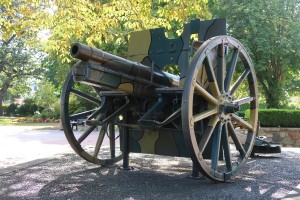
A German field gun, one of two located at Esquimalt Memorial Park.
Both guns were captured by the 2nd Canadian Mounted Rifles.
(P. Ferguson image, July 2020)
It is the complications and anticipations, the things that ought to be, that I enjoy with Parade’s End. I look forward to reading Ford Madox Ford’s books, to learn of his Groby. And with my interest in seemingly disparate connection – to have watched Parade’s End and to next having encountered Billiken – it must be…well…good fortune and good luck…the things as they ought to be…always the left shoe first.

In James Bay (Victoria), a cherry tree stands similar to the charms of the Groby Tree.
Memories of a loved ones. Long may it stand.
(P. Ferguson image, July 2020)

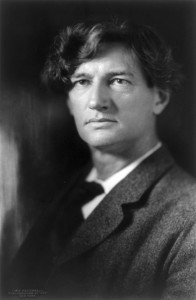
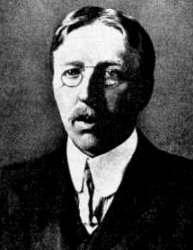
Comments